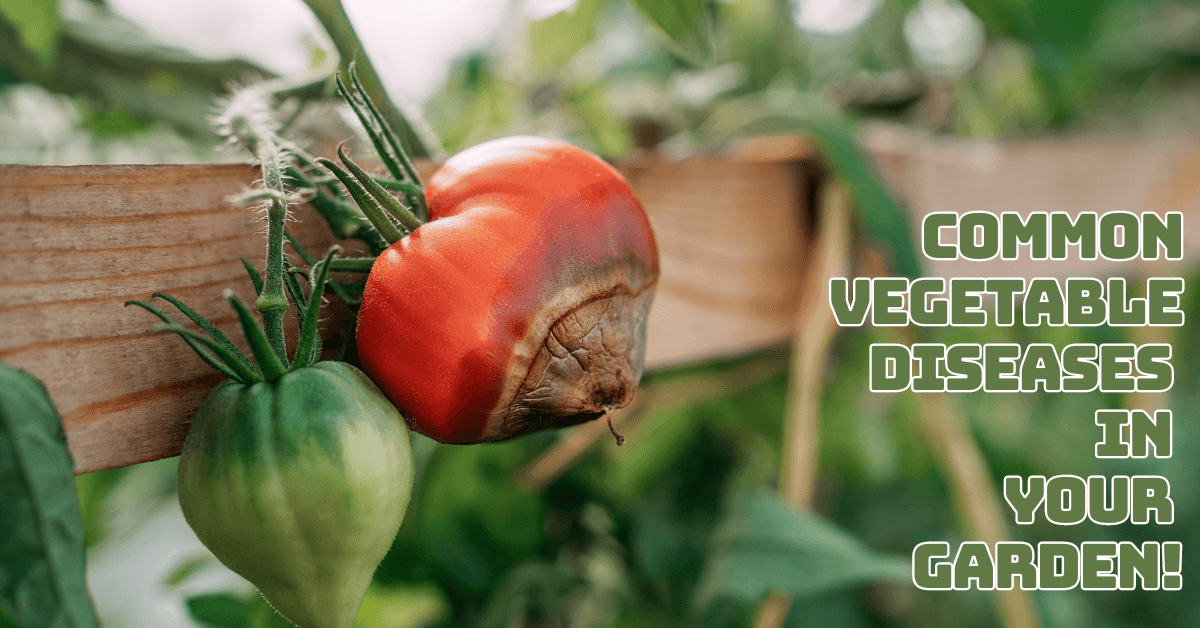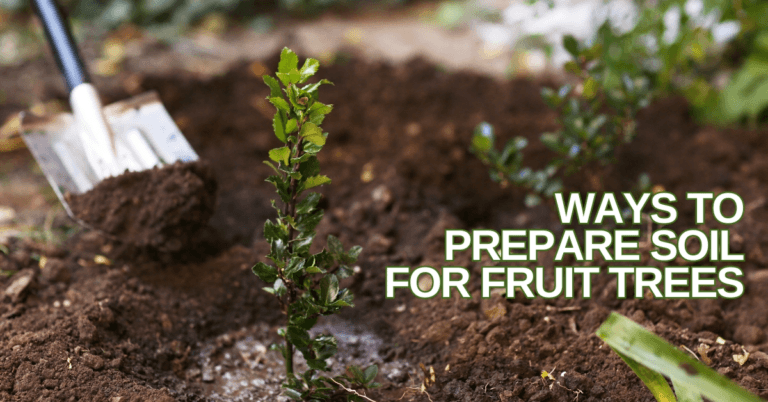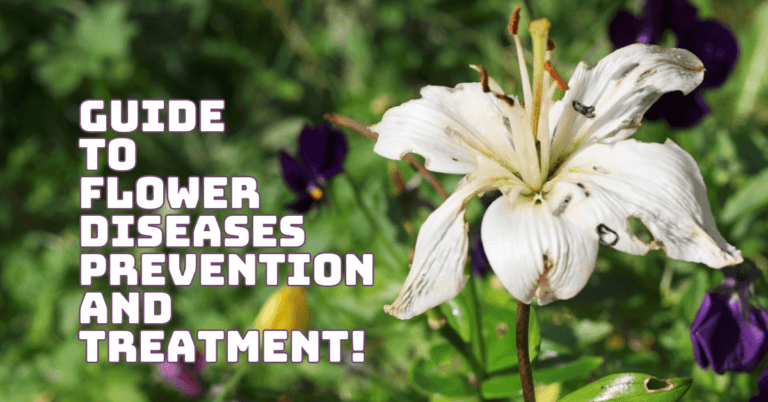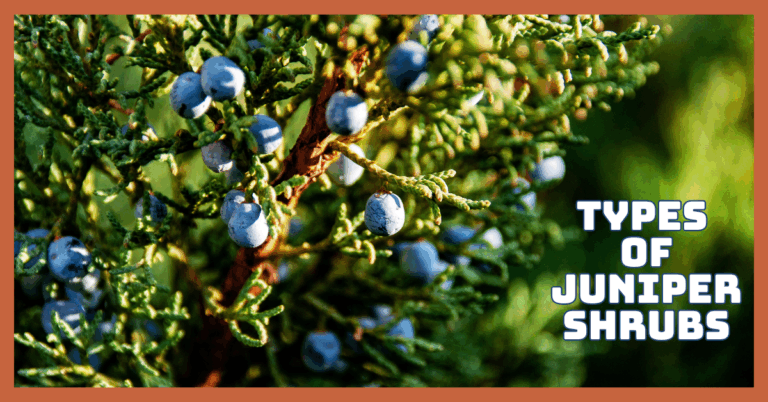Common Vegetable Diseases In Your Garden
Common Vegetable Diseases in Your Garden
Gardening is a rewarding hobby, but it's also challenging. One of the biggest challenges is managing vegetable diseases, which can significantly impact crop health and yield.
Knowing the numerous diseases that might damage your garden vegetables—from bacterial blights to fungal infections—is essential to keeping your garden fruitful and healthy.
In this article, we'll explore the most prevalent vegetable diseases, their symptoms, and effective strategies for prevention and control.
Exploring Common Vegetable Diseases in Your Garden
Vegetable crop health and productivity can be negatively impacted by several diseases that gardeners frequent. Below are a few of the most prevalent illnesses affecting vegetables:

1. Early Blight
Caused By
Early Blight is caused by the fungus Alternaria solani, which thrives in warm, moist conditions. This pathogen can survive in soil, plant debris, and seeds, making it a persistent threat in the garden.
Affects
This disease primarily affects tomatoes and potatoes, particularly older plants that are more susceptible to infection.
Symptoms
The first signs of Early Blight are dark, circular spots with concentric rings resembling a target. These spots typically appear on the plant's older, lower leaves.
The spots become larger as the disease spreads, which reduces plant vigour and yield by causing the leaves to turn yellow and drop early.
Prevention/Control
To prevent Early Blight, practice crop rotation to avoid planting tomatoes or potatoes in the same spot each year. Minimize overhead watering to keep foliage dry, reducing fungal spread.
Plant disease-resistant varieties when available, and if an outbreak occurs, apply fungicides early in the season to control the disease. Remove and discard any contaminated plant waste to lessen the chance of reinfection.

2. Powdery Mildew
Caused By
Powdery Mildew is one of the vegetable diseases in your garden caused by a group of fungi, including Erysiphe species, which thrive in warm, dry conditions with some humidity.
These fungi thrive in warm, dry environments but require some moisture to germinate, making them particularly troublesome in late summer or early fall.
Affects
This disease affects many vegetables, including cucumbers, squash, melons, and others in the cucurbit family. It can also impact ornamental plants, herbs, and fruit trees.
Symptoms
Powdery mildew disease is characterized by the development of white, powdery patches on affected plants' leaves, stems, and flowers.
These patches may swiftly cover large areas, initially starting out tiny but eventually spreading, impairing photosynthesis, growth, and fruit development.
Prevention/Control
To prevent Powdery Mildew, ensure your garden has good air circulation by spacing plants appropriately and pruning overcrowded areas.
Avoid watering plants from above, as wet foliage can promote fungal growth. If the disease appears, sulphur-based fungicides can be applied as a preventive measure or early in the infection to control its spread. Additionally, they remove and destroy infected plant parts to reduce the chance of reinfection.
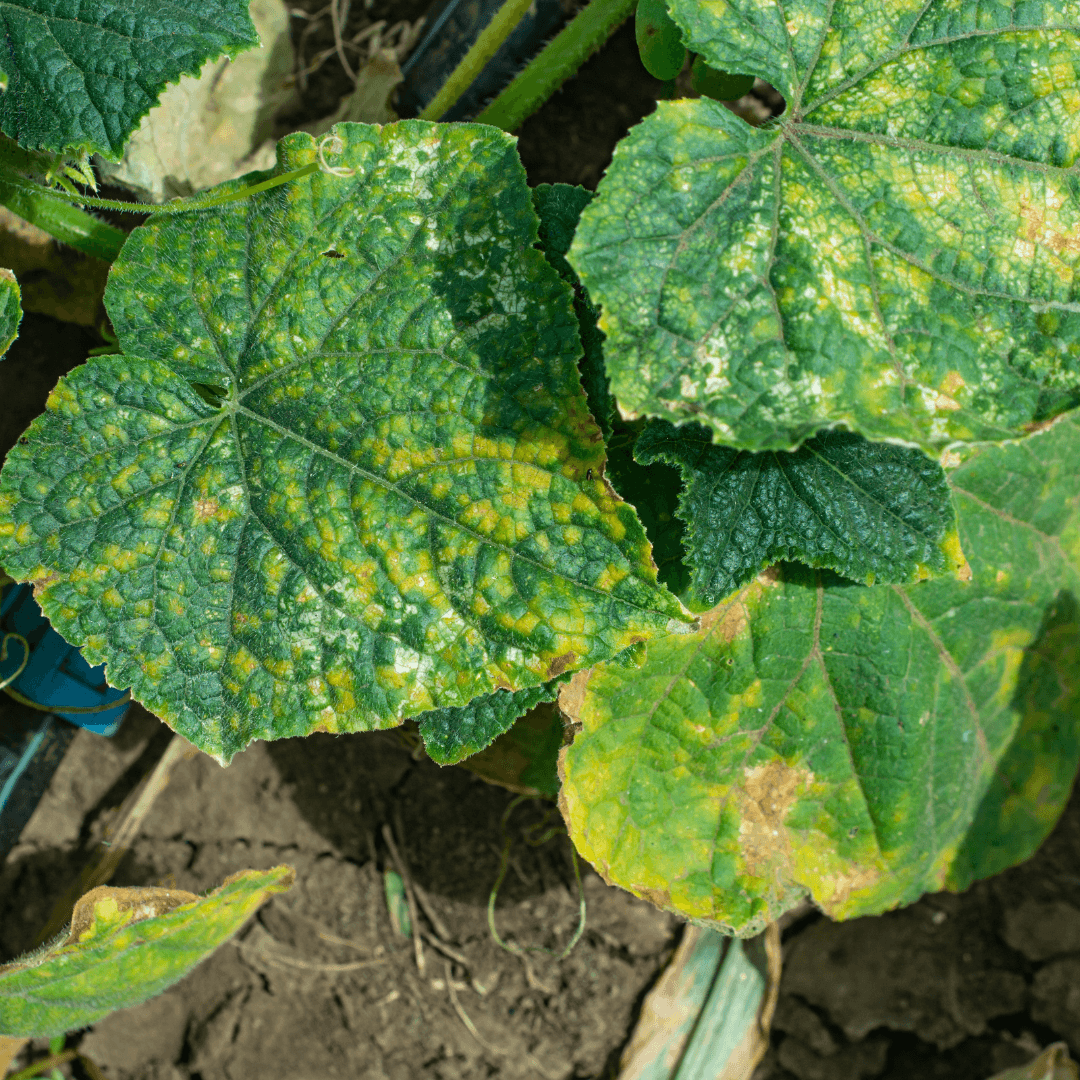
3. Downy Mildew
Caused By
Downy Mildew is caused by Peronospora species, a group of fungus-like organisms known as oomycetes.
These pathogens thrive in cool, moist environments, especially during high humidity and overcast conditions. They can spread rapidly through water, air, or contaminated plant material.
Affects
Downy Mildew primarily targets leafy greens such as lettuce, spinach, and cucumbers, but it can also affect other vegetables, including herbs and some ornamental plants.
Young plants are particularly vulnerable, and severe infections can lead to significant crop losses.
Symptoms
The disease appears as yellow or light green dots on the leaf surfaces above. These spots may initially appear angular due to their confinement by leaf veins.
On the underside of the leaves, a characteristic grayish or purplish mould forms, particularly in humid conditions.
As the infection progresses, affected leaves may wilt, curl, and die, reducing the plant’s vigour and yield.
Prevention/Control
Select plant-resistant varieties whenever possible to prevent downy Mildew. Ensure good air circulation by spacing plants adequately and avoiding dense plantings.
Water plants in the morning to avert overhead watering and to allow leaves to dry before dusk.
If an outbreak occurs, apply appropriate fungicides, such as those containing copper or other downy mildew-specific treatments, at the first sign of infection.
Regularly inspect plants and remove any infected leaves to minimize the spread of the disease.

4. Bacterial Wilt
Caused By
Bacterial Wilt is one of the vegetable diseases in your garden caused by Ralstonia solanacearum. This soil-borne bacterium thrives in warm, humid climates and spreads rapidly through the plant's vascular system.
This pathogen can survive in the soil, water, and infected plant material, making it highly persistent and difficult to control.
It enters plants through the roots and spreads rapidly through the vascular system, causing severe damage.
Affects
This disease affects many vegetables, including tomatoes, potatoes, cucumbers, peppers, and other members of the Solanaceae and Cucurbitaceae families.
It is particularly destructive in crops grown in regions with warm temperatures and high humidity.
Symptoms
The most prominent symptom of Bacterial Wilt is the sudden wilting of leaves and stems, even when soil moisture levels are adequate.
Infected plants may initially wilt during the hottest part of the day and recover at night, but as the disease progresses, wilting becomes permanent.
The vascular tissues of infected plants may show brown discoloration, and cutting the stem often reveals a slimy, bacterial ooze.
Prevention/Control
To prevent Bacterial Wilt, use disease-free seeds or seedlings from reputable sources. Practice crop rotation, avoiding planting susceptible crops in the same soil for several years to reduce bacterial populations.
Infected plants should be quickly removed and killed to prevent germs from spreading. Improving soil drainage and avoiding excessive irrigation can also help minimize the risk of infection.
Where available, solarizing soil and using resistant varieties are additional strategies to manage this disease.
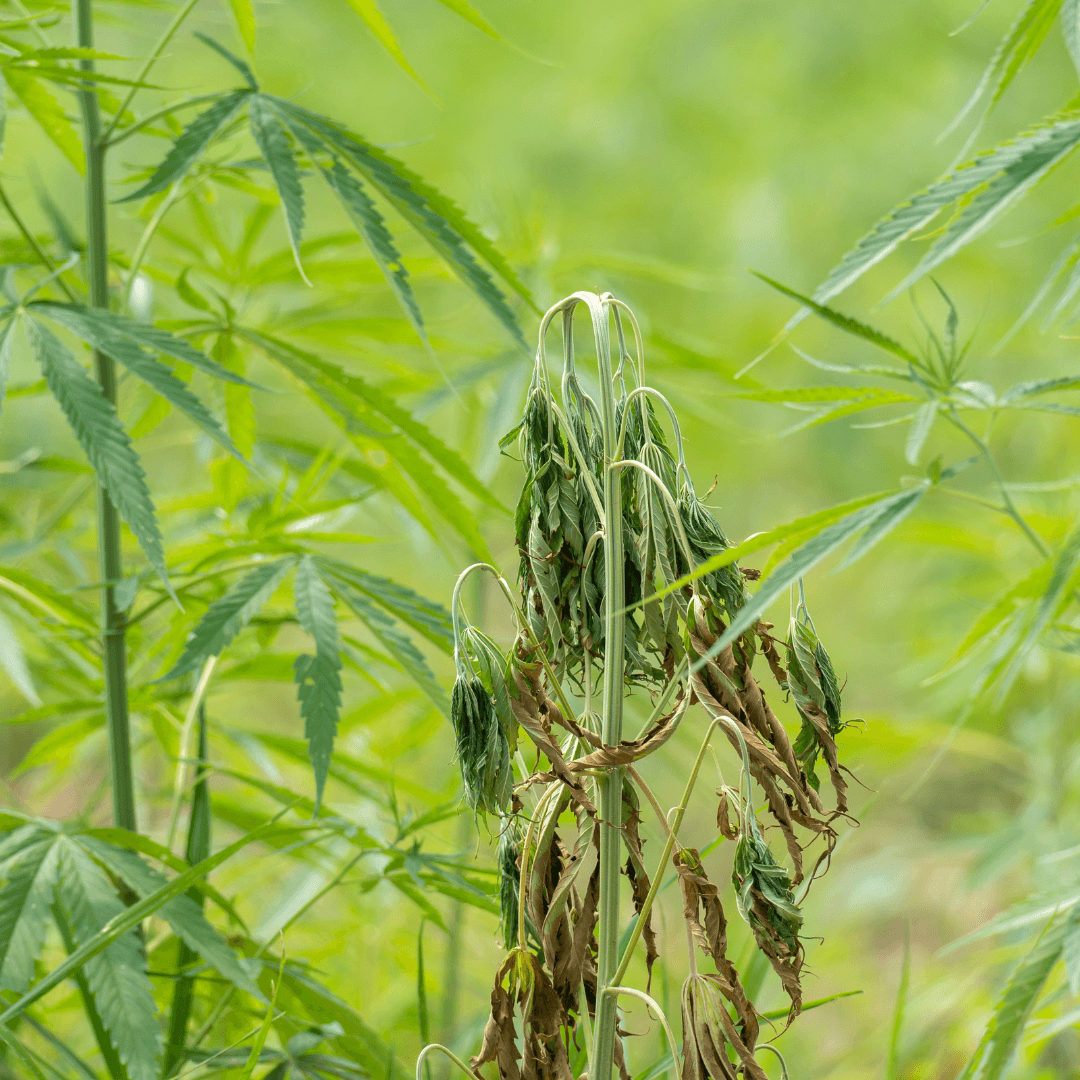
5. Fusarium Wilt
Caused By
Fusarium Wilt is caused by the soil-borne fungus Fusarium oxysporum, which can persist in the soil for many years.
The fungus enters plants by their roots and settles in their vascular system, interfering with the nutrients and water flow.
It thrives in warm soils and can be spread through contaminated soil, water, and plant debris.
Affects
This disease affects a variety of vegetables, with tomatoes, peppers, and melons being particularly susceptible.
Fusarium Wilt is especially problematic in regions with warm climates, where it can cause significant yield losses in affected crops.
Symptoms
The disease typically starts with yellowing leaves, often beginning on one side of the plant. The affected leaves may turn brown and wilt as the infection progresses, eventually leading to plant stunting and death.
When cut open, the vascular tissues in the stems often show a brown or dark discoloration, which is a key diagnostic feature of Fusarium Wilt.
Prevention/Control
Plant-resistant varieties are used whenever possible to prevent Fusarium Wilt, as this is one of the most effective control measures. Crop rotation is also crucial; avoid planting susceptible crops in the same location year after year.
Solarizing the soil with clear plastic during the hottest part of the year can help kill the fungal pathogens in the upper soil layers.
Also, maintain good garden hygiene by removing and destroying infected plants and debris to reduce the fungus spread. Improving soil drainage and avoiding over-irrigation can also help minimize the risk of infection.

6. Blossom-End Rot
Caused By
Blossom-end rot is one of the vegetable diseases in your garden. It is not caused by a pathogen but by a calcium deficiency resulting from inconsistent watering.
This deficiency often occurs due to erratic watering, which disrupts the plant's ability to absorb calcium from the soil, especially during rapid fruit development.
Affects
This disorder primarily affects tomatoes, peppers, and eggplants. It typically manifests in the season's first fruits, particularly when growing conditions fluctuate.
Symptoms
The characteristic symptom is the appearance of dark, sunken, leathery spots at the blossom end of the fruit. These spots can enlarge, leading to fruit decay and reduced marketability.
Prevention/Control
To prevent Blossom-End Rot, ensure consistent watering, maintaining even soil moisture throughout the growing season.
Avoid excessive nitrogen fertilization, which can promote rapid growth and increase calcium demand.
If necessary, apply calcium supplements, such as calcium nitrate, to the soil or as a foliar spray to help the plant meet its calcium needs. Mulching around plants can also help maintain consistent soil moisture.

7. Anthracnose
Caused By
Anthracnose is caused by fungi in the Colletotrichum genus, which thrive in warm, moist conditions.
These fungi can survive on plant debris in the soil and spread through splashing water, making them particularly troublesome during wet weather or overhead irrigation.
Affects
This disease affects a variety of vegetables, including beans, cucumbers, tomatoes, peppers, and melons.
It may seriously harm the fruits and foliage, resulting in a lower yield and lower quality fruit.
Symptoms
The primary symptoms of Anthracnose are dark, sunken lesions that appear on the fruit, stems and leaves of infected plants.
These lesions may expand on fruits and become sunken, leading to rot. On leaves, the lesions can cause premature defoliation, further weakening the plant.
Prevention/Control
Crop rotation is the technique of not planting sensitive crops in the same spot for several seasons to prevent anthracnose.
Water near the base of the plants instead of overhead, as this helps prevent the spread of fungus spores.
Applying fungicides early in the season, especially during wet conditions, can help manage the disease.
Additionally, remove and destroy any infected plant debris to reduce the source of fungal spores in the garden.
Use disease-resistant varieties when available and maintain good garden sanitation to minimize the spread of the disease.
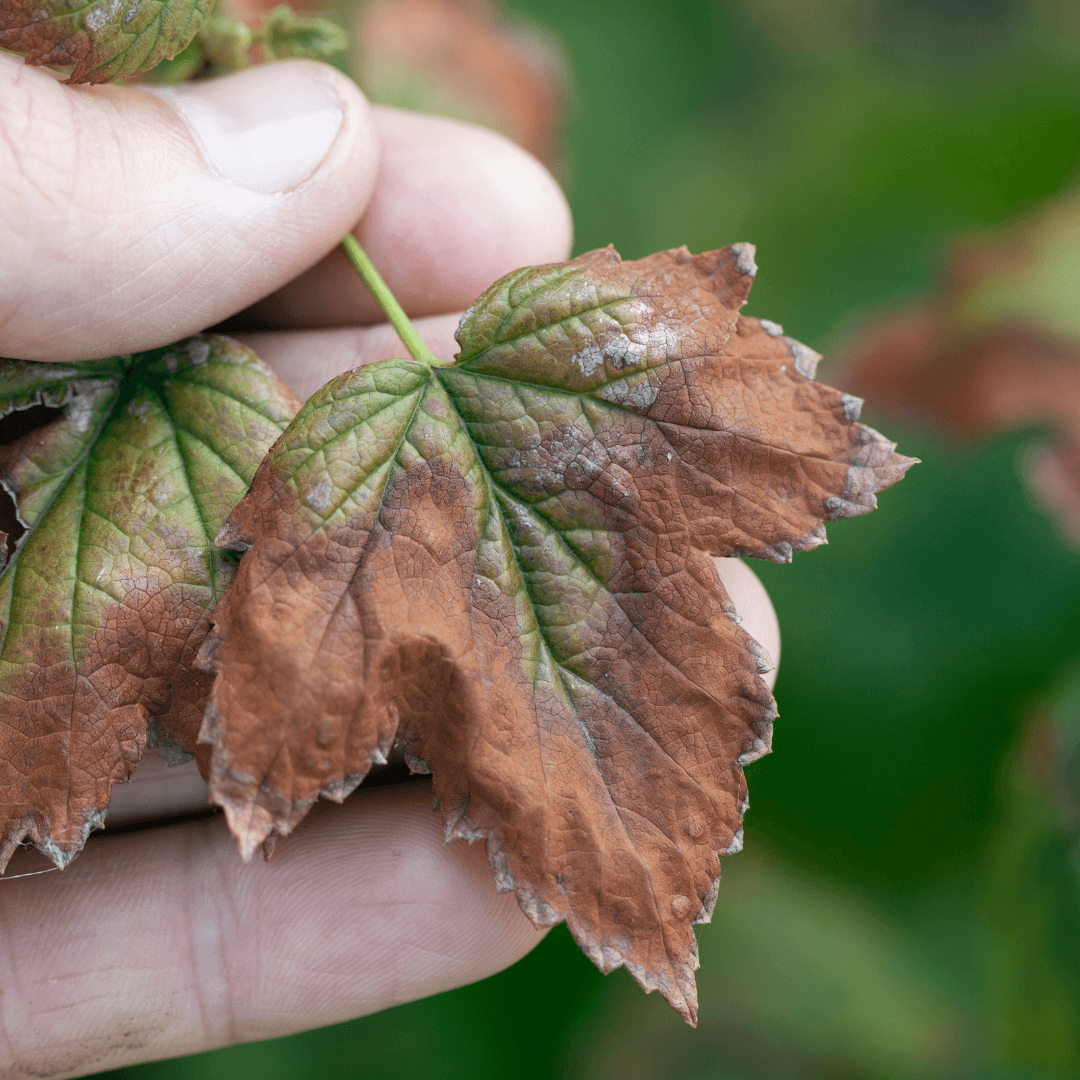
8. Verticillium Wilt
Caused By
Verticillium Wilt is one of the vegetable diseases in your garden caused by fungi from the Verticillium genus.
These fungi live for many years in the soil, damaging the flow of nutrients and water to plants by entering through the roots and propagating through the vascular system.
Affects
This disease affects many vegetables, with tomatoes, potatoes, and eggplants particularly susceptible. It can cause significant damage, especially in warm climates.
Symptoms
Verticillium Wilt typically starts with the yellowing of lower leaves, often in a V-shaped pattern. As the disease progresses, leaves wilt and drop, leading to stunted growth. Infected plants usually show poor vigour and reduced yields.
Prevention/Control
Plant resistant varieties whenever possible to prevent Verticillium Wilt. Rotate crops, avoiding planting susceptible plants in the same area for several years.
Additionally, avoid planting in soil known to be infected, and practice good sanitation by removing and destroying infected plant debris.
Improving soil health through proper fertilization and maintaining good soil structure can also help plants resist infection.

9. Root-Knot Nematodes
Caused By
Root-Knot Nematodes are caused by microscopic roundworms belonging to the Meloidogyne species.
These parasitic nematodes invade plant roots, causing significant damage by feeding on the plant’s tissues and disrupting nutrient and water uptake.
Affects
Root-Knot Nematodes affect various vegetables, including tomatoes, carrots, cucumbers, and beans.
They are particularly problematic in sandy soils and warm climates, where nematode populations can thrive.
Symptoms
Infected plants exhibit swollen, knotted, or galled roots, which impede the plant’s ability to absorb water and nutrients.
Above-ground symptoms include stunted growth, yellowing of leaves, and poor plant vigour. Severe infestations can lead to plant death.
Prevention/Control
To manage Root-Knot Nematodes, rotate crops regularly, avoiding susceptible plants in infested soils.
Use resistant or tolerant varieties where available. Practicing good sanitation, such as removing and destroying infected plant residues, can help reduce nematode populations.
Additionally, soil solarization and organic soil amendments, like adding compost, can help suppress nematodes. Incorporating beneficial nematodes into the soil may also provide biological control.

10. Late Blight
Caused By
Late Blight is one of the vegetable diseases in your garden caused by Phytophthora infestans. This destructive fungus-like organism thrives in cool, wet conditions and can spread rapidly through water, air, and infected plant material, leading to severe outbreaks.
Affects
This disease primarily affects tomatoes and potatoes, but it can also infect other nightshade family members.
Late Blight is notorious for causing devastating losses in both home gardens and commercial crops.
Symptoms
The disease begins with water-soaked spots on leaves and stems, which quickly enlarge, turning brown and leading to the characteristic blight.
Affected areas may also develop a white, fuzzy growth under humid conditions. Infected fruits and tubers rot, often with a foul odour, leading to significant crop loss.
Prevention/Control
If you want to avoid Late Blight, plant types of vegetables that don’t get the disease easily. If you see any plants getting sick, remove them and get rid of them quickly so the disease doesn’t spread to other plants.
Apply fungicides as soon as you notice an infection or as a preventative step during conducive weather, especially ones that contain copper or other targeted treatments for late blight.
To lower humidity, steer clear of overhead watering and ensure adequate airflow around plants. Crop rotation is better than yearly leaving potatoes or tomatoes in the same place.
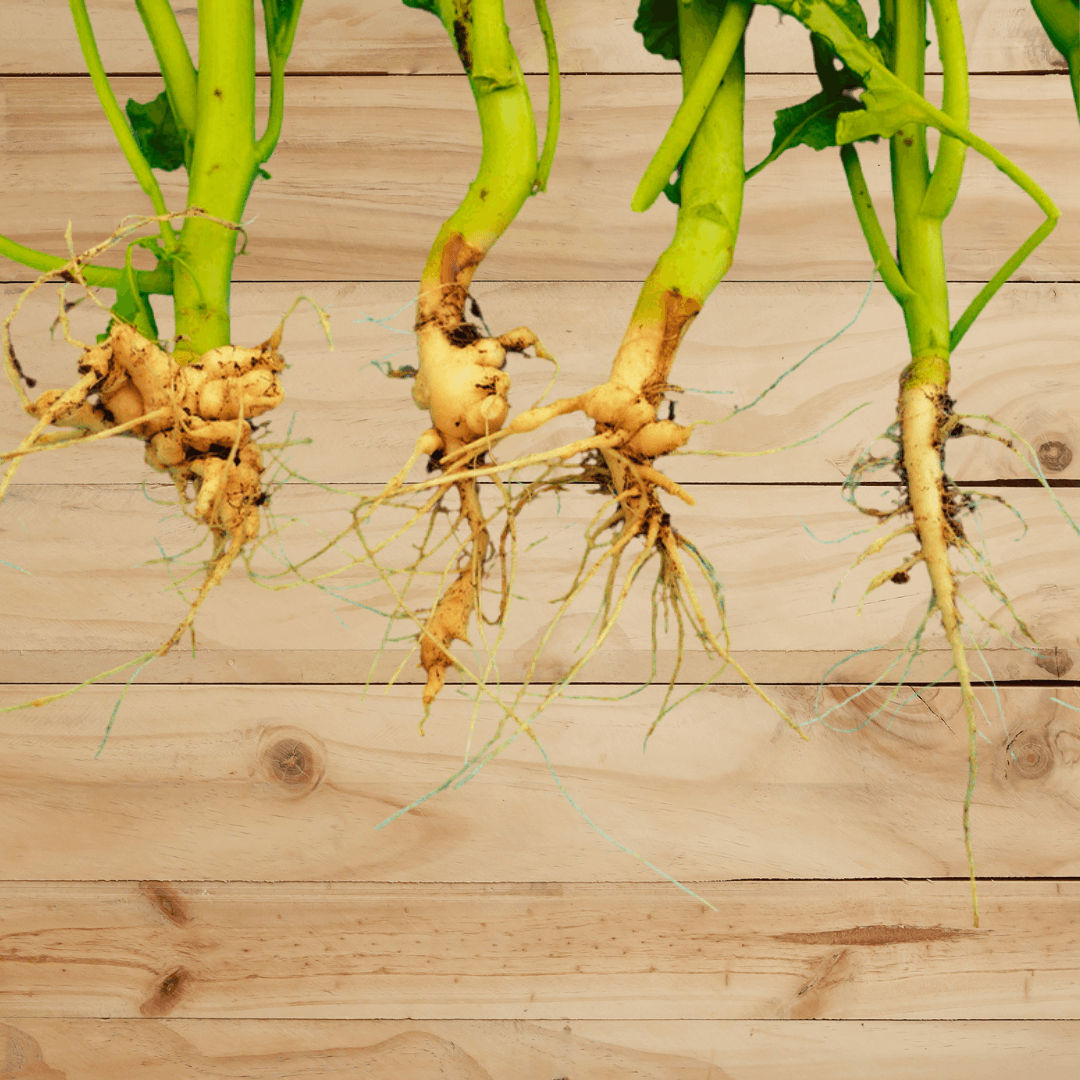
11. Clubroot
Caused By
Clubroot is caused by Plasmodiophora brassicae, a soil-borne pathogen that thrives in acidic soils and moist conditions. This pathogen infects plants' roots, causing significant distortion and swelling.
Affects
Clubroot primarily affects brassicas such as cabbage, broccoli, cauliflower, kale, and Brussels sprouts. It can cause severe yield losses, especially in heavily infested soils.
Symptoms
Infected plants exhibit swollen, misshapen roots that resemble clubs or galls. These deformed roots impair the plant's ability to absorb water and nutrients, leading to yellowing, wilting, and stunted growth of the above-ground parts. In severe cases, plants may die before reaching maturity.
Prevention/Control
To manage Clubroot, maintain soil pH above 7.2 by applying lime, as the pathogen struggles in alkaline conditions.
Rotate crops regularly, avoiding brassicas in the same area for several years. Destroy and remove contaminated plants to stop the disease from spreading.
Improving soil drainage and practicing good sanitation can also help minimize the risk of Clubroot. Additionally, consider planting resistant brassica varieties where available.
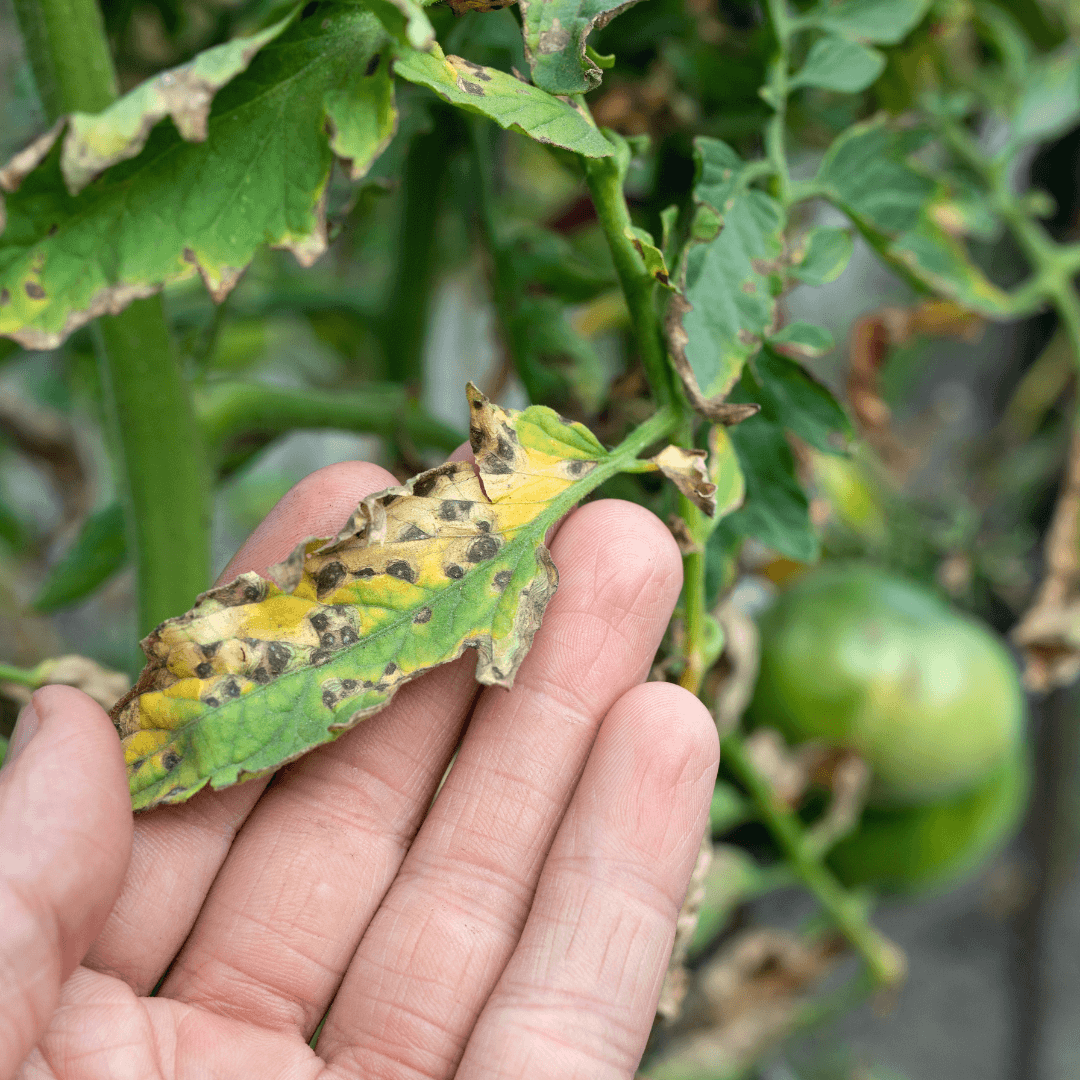
12. Septoria Leaf Spot
Caused By
Septoria Leaf Spot is caused by the fungus Septoria lycopersici. This pathogen thrives in warm, humid conditions and can spread rapidly through water and infected plant debris.
Affects
The disease affects tomatoes, particularly during the growing season when conditions are favourable for fungal growth.
Symptoms
The initial symptoms are small, water-soaked spots on the leaves, which rapidly enlarge. These spots develop dark, concentric borders, giving them a target-like appearance.
The spots may combine as the illness worsens, resulting in significant leaf damage, early leaf drop, and diminished plant vigour.
Prevention/Control
To prevent Septoria Leaf Spot, avoid overhead watering, which can spread fungal spores; use drip irrigation instead.
Regularly check your plants and remove and destroy any affected leaves to stop the illness from spreading.
Applying fungicides, particularly those containing chlorothalonil or copper, can help manage outbreaks, especially during humid conditions.
Additionally, practicing crop rotation and selecting resistant tomato varieties can further reduce the risk.
FAQ
1. When Should I Seek Professional Advice For Vegetable Diseases?
Suppose a disease cannot be controlled with standard methods or is severe and widespread. In that case, it may be time to seek advice from a local extension service or a professional horticulturist on advanced treatment options.
2. Can Vegetable Diseases Spread From Plant To Plant?
Many vegetable diseases can spread through direct contact, contaminated tools, soil, or water. To minimize the risk, avoid working with plants when they are wet, and sterilize tools and equipment regularly.
3. How Can I Control Cucumber Mosaic Virus (CMV)?
Control CMV by using virus-resistant plant varieties, managing aphid populations with insecticides or natural predators, and removing infected plants from your garden to prevent the virus from spreading.
4. What Causes Root Rot In Vegetables, And How Can I Prevent It?
Pathogens cause root rot in poorly drained or overly wet soil. To prevent root rot, improve soil drainage, avoid overwatering, and use well-draining pots or beds. Also, ensure that your soil is amended with organic matter for better drainage.
5. How Do I Treat Downy Mildew On My Vegetables?
Treat downy mildew by improving air circulation around plants, removing infected leaves, and applying appropriate fungicides. Ensure that plants are not overcrowded and avoid overhead watering.
6. What Is The Difference Between Early And Late Blight In Tomatoes?
Early blight causes concentric rings and dark spots on older leaves, while late blight leads to grayish mould and dark, water-soaked lesions on leaves and fruit. Late blight spreads more rapidly and can be more severe.
Conclusion
Maintaining a healthy garden requires vigilance and proactive care to prevent and manage common vegetable diseases.
Remember, you can lower the risk of infection by using plant varieties that are resistant to diseases., practicing crop rotation, maintaining a clean garden, and being vigilant for signs of disease.
Regular monitoring and early intervention ensure your garden remains a thriving, productive space.
Using these techniques, you can reap the benefits of a plentiful harvest and the knowledge that your vegetables are disease-free and nutritious. Happy gardening!
I trust you enjoyed this article, Common Vegetable Diseases In Your Garden. Please stay tuned for more blog posts soon. Take care!
JeannetteZ
>>>Please click here to read my all-inclusive article, About The Essential Companion Planting Guide<<<
>>>Please click here to read my all-inclusive article about Container Gardening<<<
>>>Are you interested in homegrown herbs and medicine? Please click here to find out more about it!<<<
Your Opinion Is Important To Me
Do you have thoughts, ideas, or questions? I would love to hear from you. Please leave me your questions, experiences, and remarks about this article, Common Vegetable Diseases In Your Garden, in the comments section below. You can also email me at Jeannette@Close-To-Nature.org.
Disclosure
This post may contain affiliate links. As an Amazon Associate and other affiliate programs, I earn from qualifying purchases at no extra cost to you. Please read my full affiliate disclosure.
You might also enjoy these blog posts:
The Benefits Of Vajrasana Yoga
The Surprising Benefits Of Goat Yoga
Interesting Facts About Cardinals
All About Lilies: Your Ultimate Guide!

